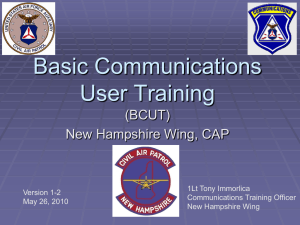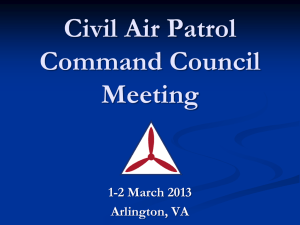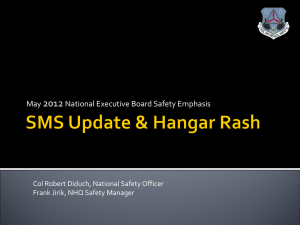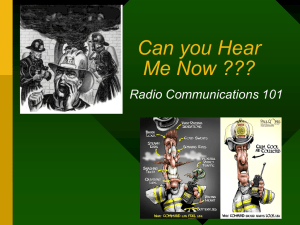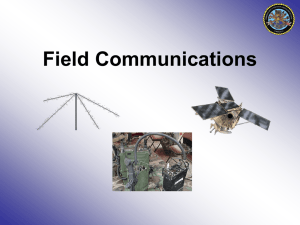REPEATERS - The Civil Air Patrol is a federally charted organization
advertisement
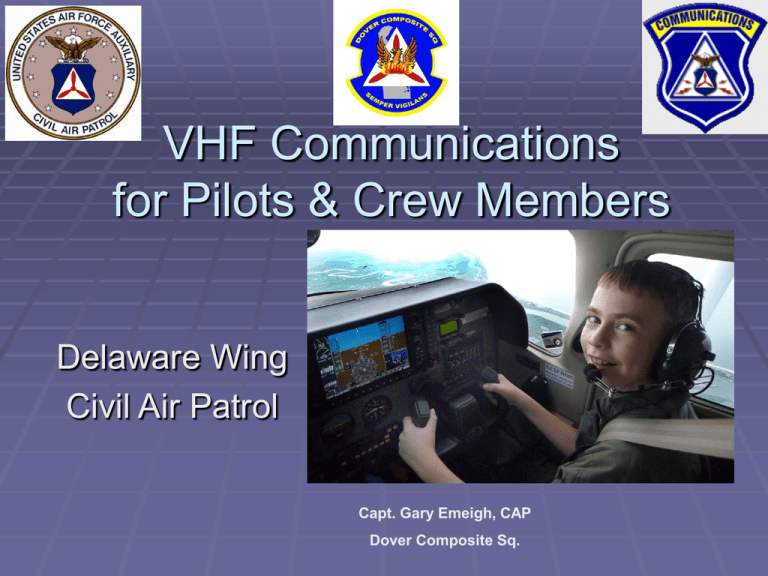
VHF Communications for Pilots & Crew Members Delaware Wing Civil Air Patrol Capt. Gary Emeigh, CAP Dover Composite Sq. VHF Communications Review of CAP VHF Communications, regulations and capabilities Air-band AM radios vs. CAP FM radios Protocols and proper operation of aircraft VHF resources Repeaters – uses and pitfalls New information on Altitude and frequency restrictions Encryption 2 Air-band vs. CAP Radios What’s different Authorization Air-band Radios are licensed by the FCC through the FAA Pilots operate under a radio certificate tied to tail number CAP mission base has a blanket authorization to operate CAP Radios are licensed by the NTIC through the Air Force CAP Radio Stations must be under the direct supervision of a properly authorized Civil Air Patrol radio operator [i.e. have had BCUT as a minimum] Modulation Air-band: AM CAP: FM CAP radio transmissions may also be digital [P25] and encrypted Frequencies Air-band: open to the public CAP Frequencies designated “For Official Use Only” – Actual frequencies cannot be disclosed to anyone or broadcast Not available through the Freedom of Information Act 3 Radio Basics AM vs. FM 4 Amplitude Modulation AM • Worldwide standard for aircraft communication • Very old type of modulation first used in early development of radio • Tends to be noisy, easily interfered with. Allows lots of static and ignition noise. Bad feature. • Allows two stations to be heard over one another – i.e. no capture effect as with FM. 5 Frequency Modulation FM FM is used by CAP for VHF radios in vehicles, aircraft, walkie-talkies and base stations. Short range. The advantage is less static from ignition systems in vehicles, and excellent audio quality. FM also has a “capture effect” where the strongest station comes in over a weaker station. CAP also uses FM in the ISR UHF radios. 6 CAP Radio Equipment and Operation 7 Types of radios EJ Johnson Base Radio Mobile Radio Portable Motorola HF 800 Mhz ICOM ISR Aircraft Radios Aircraft use two types: AM – used mostly by pilots to communicate with Air Traffic Control. FM – used primarily by Mission Observer to communicate with Mission Base 8 Delaware Wing has the added complication of an 800 mhz radio installed in aircraft for communication with state agencies. Make certain you have switched the necessary COMM 3 select from 800 mhz (or UHF) to Normal (or VHF) before trying to use the CAP radio. CAP utilizes one of the two following types of radios installed in aircraft. Technisonic Model TDFM-136 Aircraft VHF CAP Radio Main: On / Off – Main volume Guard: Guard channel volume Squelch: Push for open squelch MN/GD: Transmit channel select G1/G2: Sets Guard Channel Hi/Lo: Power – 1 or 10 watts. 1: N/A 2: Display brighter 3: N/A 4: Channel scroll down 5: N/A 6: Channel scroll up 7: N/A 8: Display dimmer 9: N/A 1, 3, #, 0, 7, 9: USED FOR PROGRAMMING RADIO! Main and Guard knobs for volume. Use 4 and 6 buttons to select desired CAP channel. 2 and 8 for display brightness. Three switches at bottom left are normally kept up. NPX-138 MN Knob: On / Off and Volume for main channel GD Knob: Guard Channel Volume in Norm position Scan/Norm/GdTX: Keep in Norm position GD1/GD2: Guard Channel 1 or 2 select. Usually kept in GD1 position DISP: - Always Leave on (ID) display CHAN: Toggle left/right to scroll main channel BRIGHT: Display brightness up or down. EDIT: For PROGRAMMING! (Leave in center position) SQ: Press for open squelch BASE STATIONS and MOBILES PUSH TO CHANGE POWER SETTING. Display now shows: Command Control 1, Zone 2, and channel 1 Keep on HIGH. TO CHANGE CHANNEL: Press SELECT knob to move cursor above channel. Turn knob to desired channel. Channel description changes when you change channel On/Off Volume ALL DEWG CHANNELS ARE IN ZONE 2 TO CHANGE ZONE Press SELECT knob to move cursor above Zone as shown. Turn knob to desired zone. Radio is now in SCAN mode which is a configuration not normally used during SARs. Press SCAN button to scan all channels, or to stop scanning. This icon shows radio is scanning Repeaters 14 Simplex vs. Duplex Simplex Transmit and receive on the same frequency Line of sight – Buildings and terrain block signals. Duplex Transmit on one frequency and receive on another Single Frequency One Station at a Time R T Two Frequencies One Station at a Time Repeaters – Duplex mode Used to extend coverage and get over obstacles Repeater increases the range of mobile stations due to its high profile location 15 DEWG VHF Communications Delaware Wing maintains 3 VHF repeaters Locations were chosen to give statewide coverage Bethel - Northern Delaware Woodside - Central Delaware Rehoboth - Southern Delaware Highbird Repeater * – Utilized by aircraft as assigned by the IC. Requires ACUT operator VHF Frequencies [Channels] are programmed to show the repeater location [Tag], not the frequency Frequencies are FOUO – do not say frequencies on the air 16 Aircraft use of Repeaters Primary mode of operation should be simplex Only use the repeater if simplex is not possible 17 Delaware Wing Communications 18 Aircraft VHF-FM Radio Channel Plan * Note: Aircraft Radios do not use Zones CC1 CC2 AIR1 AIR2 Guard TAC1 R67 R68 R69 R70 R63 R64 ALT R65 ALT R66 SIMPLEX Woodside Rehoboth Bethel Salisbury Easton Harford Lakehurst Hammonton REPEATERS [DUPLEX] REPEATERS [DUPLEX] CAPGUARD is restricted to use ONLY for initial contact Aircraft should monitor CAPGUARD to maximum extent possible * Subject to change Current as of 30 Jan 2010 for Technisonic TDFM 136 Radio 19 Operating Procedures 20 Identifying Which Radio You Are On When calling a station on the CAP Assigned FM frequencies, use the Channel Designator in your initial call-up “Dover Base this is CAP Seven Twenty-Two on Air 1, over.” DO NOT use “VHF, FM, Foxtrot Mike” to identify the radio equipment you are using This avoids confusion at Mission Base which may be monitoring different frequencies on several different radios When calling on the Air-band radio, use normal pilot protocol or announce the frequency Dover base this is CAP Seven Twenty-two on 122.9.” 21 PROWORDS Prowords are a special set of words used for clarity and brevity in communications. Some of the most commonly used prowords are: THIS IS ROGER OVER OUT WAIT SAY AGAIN CORRECTION WILCO AFFIRMATIVE Preface to your call sign Last transmission received OK I’m done, go ahead I’m done, bye I will be back in a few seconds Say that again Oops! I really meant to say ROGER and I will comply Yes CAPF 100-1 dictates use of pro-words on CAP Frequencies 22 I SPELL / FIGURES / INITIALS Use “I SPELL” to clarify words or when signals are weak Example: LODI “I SPELL LODI LIMA OSCAR DELTA INDIA LODI” Use “FIGURE(S)” AND “INITIAL(S)” for non-words Example: N46 26.15 “INITIAL NOVEMBER FIGURES FOUR-SIX, TWO-SIX DECIMAL ONE FIVE ” Corrections Use proword “correction” Example: “… Turn right at next corner … CORRECTION Turn left at next corner…” 23 QUESTIONS? Questions? Lt. Bill Mervine during Form 5 in Dover Squadron’s new Highbird 24

